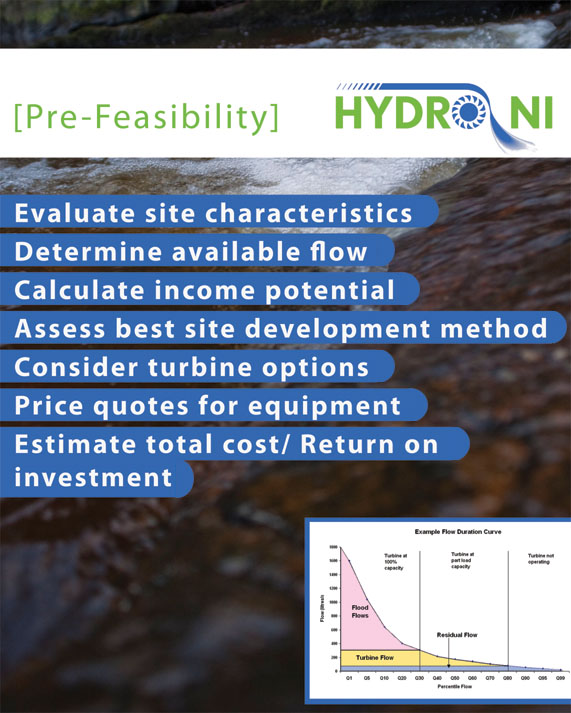Step 2

Most site owners are not from a technical background and the HydroNI feasibility report is written in plain simple language that is easy for the site owner and their family to read and understand. Once the feasibility report has been completed HydroNI meet the site owner and their family at a time that is convenient for them and talk them through the report, answering any questions that may arise.
Each potential hydro site is unique to the site owner. The volume of water, height difference, environmental considerations, ease of access and distance to the electricity grid varies from site to site. Each hydro site requires a feasibility study that specifically addresses the characteristics and requirements of the specific site.
The feasibility report is a very important step in the process of developing a hydro site that should be completed before the site owner incurs cost on drawings, planning application, etc. The site owner usually wants to know what their expected income will be, how much will it cost to develop the project and is the proposal financially viable. A typical feasibility report will cover the following.
The site owner will already be aware of many of these. HydroNI will look for things such as
-Is this a green field site or an old mill site?
-What is the head (height difference between where the water is removed from the stream and where it returns)
-How far away is the electricity grid?
-How easy will access be for construction vehicles?
-Does the site owner have any specific requirements, e.g. integrating any new buildings with an existing dwelling or listed building?
A good understanding of the available water flow is key to the success of any hydro project. Rainfall varies depending how far West or East the site is located and this will affect the available water flow. Water flow increases the further down a valley the hydro site is located, with small streams joining the main stream at various intervals.
HydroNI will develop a flow duration curve for the specific site. This identifies the volume of water to be used for hydropower and the residual flow to be left in the stream to protect fish life.
The site visit is a very important stage of assessing a potential hydro power site. The site visit gives us more information which we use to determine if a site is viable for hydro power or not. We will give the client our honest opinion of the viability of the site at this stage. While many sites that we visit will be viable, we sometimes need to advise the client at this stage that the site is not viable and that they should not spend money on it.
Assess Best Site Development Method
As part of developing the pre-feasibility report consideration is given to how best to develop the hydro potential of the site. What structures are already in place? If there is an existing weir, what condition is it in? Can an existing mill race be used? Can a pipe be used to convey water from further upstream, thereby increasing the head pressure and hence the power output? Does site access present any problems? Are there any environmental considerations?
Certain turbines are more suited to particular site characteristics than others. HydroNI will consider the head and flow available at the site and select a turbine type that is most suited to the specific site requirements.
Hydro turbines are manufactured specially for the site where they will be installed and are not available "off the shelf". Where a penstock (pipeline) will be used to convey water to the turbine the penstock needs to be correctly sized and pressure rated to the requirements of the site. To make the cost estimates within the pre-feasibility report as realistic as possible, HydroNI obtains price quotes for the pipes, valves, turbine, generator and control panel.
Estimate Total Cost & Return On Investment
HydroNI examines all the elements of developing the project: planning application, equipment cost, construction cost, grid connection, grants, etc. and estimates the total construction cost before and after grant.
The income potential developed earlier is used together with the estimated total construction cost to calculate the return on the clients investment and the number of years required for the project to pay for itself.


